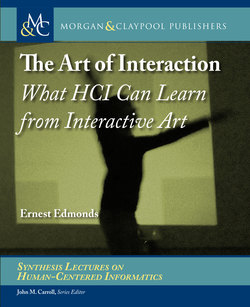Читать книгу The Art of Interaction - Ernest Edmonds - Страница 12
На сайте Литреса книга снята с продажи.
ОглавлениеCHAPTER 3
Learning from Interactive Art
3.1 A LITTLE ART HISTORY
We may often think in terms of emotion and feeling when we look at, or listen to, art. In the theatre we may see a production that exudes magic. But the works we see and hear are, of course, made by careful and informed hard work, certainly not by magic. The image of a mad genius pouring out their anguish or joy has little to do with the reality of making art. Vincent van Gough may have had problems, but he was a highly learned man who was very deliberate about the way he constructed his paintings.3 In what follows, I will look at art practice, how artists work, rather than at the artworks that they produce.
Just as in any other walk of life, the artist must conduct at least personal research. For example, an artist might need to work out which kind of paint will provide the best colour range. In fact, art practice can be seen as akin to research in that each artwork is a kind of experiment from which the artist learns, and that influences what is done next. Many artists share this attitude whether they use the word “research” or not. In his classic book The Story of Art, Gombrich even headed his chapter on the first half of the 20th century with the title “Experimental Art” (Gombrich, 1972). The art historian Stephen Bann explained this view of art practice:
“my own definition of the experimental painter is that he is committed to a particular path of controlled activity, of which the works which he produces remain as evidence. In other words, the direction in which the artist moves is at least as important as the individual statements which record the track that he has taken.” (Bann, 1970)
From the early years of the 20th century, explicit and public reference to research became an important part of some artist’s lives.
